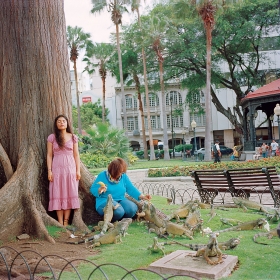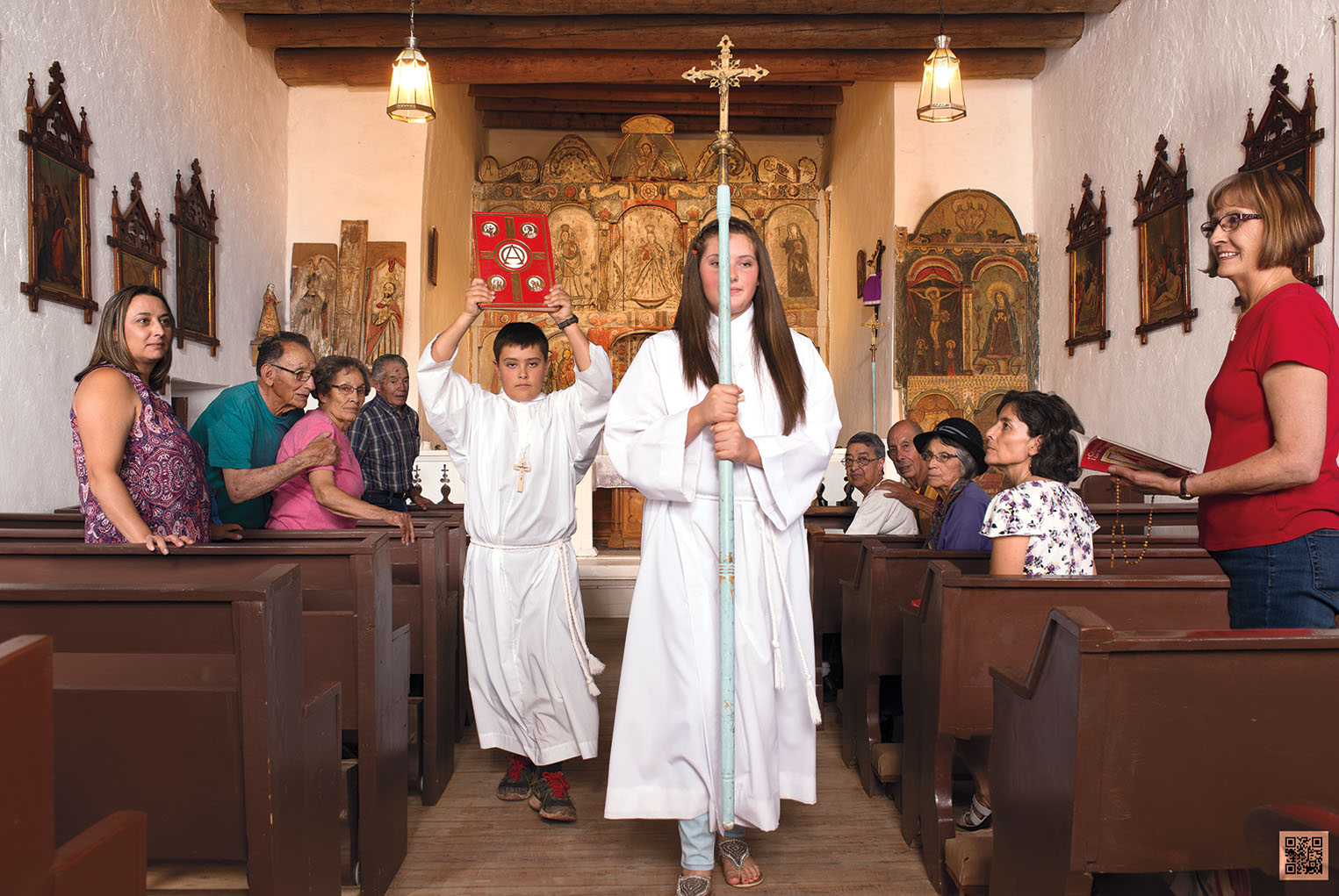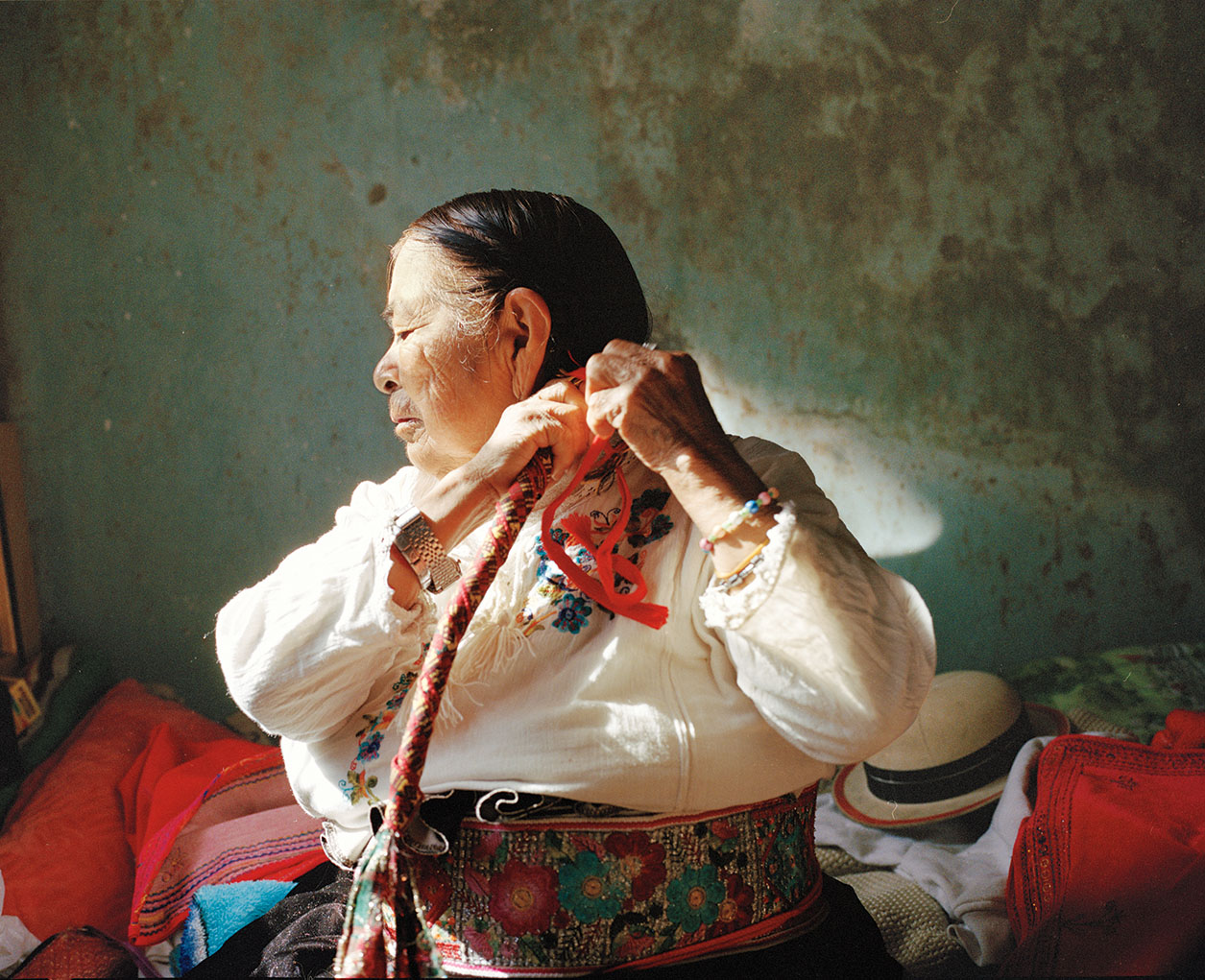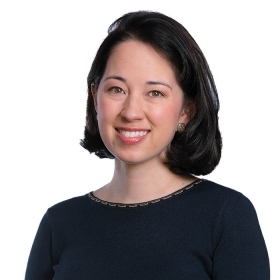Curator and writer Elizabeth Ferrer ’80 wrote Latinx Photography in the United States to fight the invisibility of Latinx photographers in the art world.
Sandra Riaño ’21 interviews curator and writer Elizabeth Ferrer ’80 about her work to fight the invisibility of Latinx photographers in the art world.

Karen Miranda-Rivadeneira, Mom healing me from my fear of iguanas, by taking me to the park and feeding them every weekend, 2012.
Ever since Sandra Riaño ’21 transferred to Wellesley as a sophomore from Nassau Community College in New York, she’s immersed herself in the study of history through the lens of visual culture. “It’s a concentration that examines the intersection of race and culture across history through images,” says Riaño, who was born in Colombia and moved to Long Island, N.Y., when she was 5. “I started taking photos at Wellesley and doing portraits and thinking more broadly about the history of portraiture itself and trying to square Latinx diaspora art within that history and not really seeing it very well represented. It was really hard to get a sense of what that history even was.”
In the fall of 2020, when Riaño took a semester off to pursue her interest in podcasting at the Futuro Media Group, she continued to fuel her passion for the arts by taking advantage of free online events held by museums during the pandemic. She attended an event hosted by the Whitney Museum of American Art on the occasion of the publication of Latinx Photography in the United States: A Visual History, written by Elizabeth Ferrer ’80, who she didn’t know was a Wellesley alumna. Later, in the spring semester, she spoke with James Oles, senior lecturer in art, about Ferrer and her book, the first to examine the history of Latinx photography.
“He asked me, ‘Did you know Ferrer is class of ’80?’ … And I was like, ‘Oh my goodness!’ It’s so wonderful to know that there’s this legacy of Wellesley students that comes before you who are doing the work that you’re interested in, and you can tap into that,” she says. “That was a really magical, full-circle moment, to find that Ferrer had gone to Wellesley and had studied Latinx art and was thinking about the same questions.”
Ferrer, a curator and writer specializing in Latinx and Mexican art and photography, has curated major exhibitions of modern and contemporary art for numerous venues in the United States and Mexico. She is currently chief curator at BRIC, an arts and media organization in Brooklyn, N.Y. Riaño asked Ferrer to talk with her about Wellesley and their shared interest in Latinx photography. Following are excerpts from one of their wide-ranging conversations, edited for length and clarity.
“The main reason I wrote the book was because there had never been a book on Latinx photography. It’s not taught in schools. It’s not collected by museums. You know, there is still this invisibility that needs to be fought against.”
—Elizabeth Ferrer ’80
Riaño: Tell us about your path to Wellesley.
Ferrer: I am originally from Los Angeles and grew up in East LA, which was a predominantly Mexican American neighborhood, and loved art from when I was a little kid, and began college by studying photography at Immaculate Heart College in Los Angeles, thinking that I might actually become an artist. It was a very progressive art school. The art history program was very much guided by the spirit of Sister Corita Kent. She had this way of teaching that was just super liberating and very influential. She would take the students to the supermarket across the street, and they would make art about the signs and the fruit and the messages. You know, so Wonder Bread would become a silkscreen that would be about wonderment. Corita was no longer at Immaculate Heart when I was there, but that spirit was part of the way that I studied art.
But then I realized that I wanted to get a more rigorous art history education. So I began to look at schools and discovered Wellesley and got in, and was a transfer student. And I really found myself there in terms of what I wanted to do with my career. Wellesley has always had a really strong art history department. I had wonderful professors. It was very rigorous. I learned about so many areas of art history, Renaissance art and Asian art, especially. But what I didn’t learn about was Latin American art, about Latinx culture in general.
I want to dig into your experiences at Wellesley. What were some of the questions you were asking in your study of art history? And did you have any formative moments that shaped your art career afterward?
Wellesley was just a very positive, great experience for me. It was hard to be a transfer student, as you would know, coming in and a lot of relationships have already been established. That’s always difficult, but it wasn’t a huge impediment. I especially found the art history department very welcoming. My student job was to work at the museum. This was before the beautiful Davis Museum had opened, but there was a nice museum in the Jewett Arts Center. My job was to update the records of alums, because Wellesley tracked who got a curatorial job or who had moved up to director or who had written an important book.
That was a real eye-opener because growing up in East LA, I didn’t have a lot of exposure to art, and certainly not to art careers. When I was a little kid, I thought if you liked art, you became an artist, and I didn’t really know much else beyond that when I was younger. But at Wellesley, seeing this large database of women who were accomplishing all these exciting things, that made me realize that there was so much opportunity and possibility.
Let’s turn to the incredible photographers in your book. Tell me more about Delilah Montoya and Karen Miranda-Rivadeneira.
They’re very diverse. Delilah is a Chicana from Texas and has had a long career in Texas and New Mexico. Karen is Ecuadorian American, raised in New York and also in Ecuador. Their bodies of work are very different … but what’s interesting about both of them is the freedom that they bring to the photographic medium. They’ve both worked with different approaches to photography and different subject matter. Their work demonstrates the potentialities of photography to be such an open medium where one can document in a kind of purist, rigorous way, and one can also create work using constructed forms of composition or even by integrating fields that are totally outside of photography.
Karen’s newest body of work has a lot to do with ideas around healing. She is studying to be a shaman, and she has collaborated with Indigenous artists in her native Ecuador. And so the idea is to bring ideas of healing into her practice in work that involves photography, performance, video, and objects.
Likewise, one of Delilah’s more recent bodies of work is on the theme of family, but it also involves science. She has worked with many different kinds of families, documenting their home life, their everyday life. But then, with each family that she works with, one individual will have a DNA test. And so along with a large panoramic photograph that captures an emblematic moment in that family’s life, she’ll exhibit evidence derived from the DNA. So in doing that, she documents the ethnic roots and geographic roots of a family. There are always surprises. … One can trace roots back to Egypt or to Asia, and you know, discover all these combinations. Most of the families, I think, are Latinx, not all. Using art and science, she’s telling a very interesting story about who we really are, what are our roots, where we came from.
So for me, the idea of bringing the art of healing into one’s work, or bringing scientific ideas into your work, stretches the definitions of what photography can be. But at the same time, I think both of these photographers make work rooted in explorations of identity.

Delilah Montoya, Contemporary Casta Portraiture: Nuestra “Calidad,” Casta #1. To see Montoya’s full series of 16 family portraits along with DNA test results and hear audio “family monologues,” visit delilahmontoya.com/ContempCasta.
Karen Miranda-Rivadeneira, Mama Matilde braiding her hair, from the series Piedra Redonda, January 2020.
Speaking of stretching the definitions of what photography can be, I am reminded of the second chapter of your book, “The Rise of a Latinx Consciousness in American Photography, 1960s–1980s.” You describe it as a turning point, and I think of the work of Hiram Maristany, who I discovered at Wellesley in my study of the Young Lords [a radical social activist group founded by Cha Cha Jiménez and Puerto Rican youth in the 1960s] and who documented El Barrio as a photographer of the people. What does this moment in history signal for the photographer?
I loved learning more about that era and want to keep working on it, because it’s still not very well studied. Chicanos in California and throughout the Southwest protesting against the Vietnam War, protesting for better schools, for more economic opportunity, and of course the Young Lords in New York. This is the nadir in New York when neighborhoods are just falling to pieces as landlords are torching their apartment buildings rather than investing in them, and there’s tremendous white flight. Tax revenues are falling so the city is not providing any services, and the first communities that they decide to cut services to are the communities of color. So the Young Lords are protesting and organizing offensives and actions against that while also providing basic services like breakfast programs for kids, because people need better diets. So there are massive social issues, and activism is rising up all over the United States.
So what’s interesting is that the early ’70s sees the first substantial generation of Latinx people graduating from colleges and attending art schools. A much bigger number of people have the means and the education to turn to photography. It’s happening at the same time that all these protests are taking place. And then the other thing that’s happening is that photography is coming into its own as an art form. Photography begins to attain a market value, so more commercial galleries are opening. So all these things are coming together.
There are suddenly young photographers who want to document Cesar Chavez and his activities in the central valley of California. They are covering the marches, the lives of farm workers, student protests that happen in LA, the high school lockouts. And the same thing is happening in New York, right? Hiram Maristany was one of the most important photographers, but there are others who are going out in the streets, documenting the Young Lords’ protests and actions, and also photographing everyday life.
[supporting-images]
What’s so important to realize is that these communities, like East LA where I grew up, or Spanish Harlem, parts of the Bronx, they were being documented primarily by outsiders. But there were also insiders like Hiram, who is finally being recognized. His photographs have been preserved and, amazingly to me, are also now being studied at Wellesley. And there was a major Young Lords museum exhibition. So there’s a drive in New York among various people and institutions to preserve this work, study this work, document this work.
But for me, this generation represents the beginning. I think even if one is doing more conceptual work or forms of constructed photography, this consciousness of who we are, and that we need to speak for ourselves and can do it through photography, that’s something that began in this generation and that continues to this day.
You’re now chief curator at BRIC, a leading arts and media gallery in Brooklyn. Where do you see Latinx photography and art in the future, and what are your hopes for contemporary Latinx artists?
It’s an exciting time for Latinx photographers, because there are so many more opportunities than there have been in previous generations. There’s a strong interest right now, I think in many quarters, to expand the canon. You know, at the same time, there’s still a lot of racism, and there is still a lot of work to do. But just one example is the fact that a lot of museums now are finally understanding the need to expand and diversify their curatorial staff.
And then there are organizations like BRIC, where I work. Being inclusive and placing a heavy focus on diverse voices, that’s just part of our DNA. That is what we do. And so I’ve been able to curate exhibitions of, just for example, Juan Sánchez, who’s a pioneering Puerto Rican artist in New York. The Whitney Museum had six Puerto Rican artists in the last biennial in 2019. So suddenly, major galleries now want to think about Latinx artists. That’s important. That’s really good. I can only hope that that trend continues. I would also point to the Latinx Project at NYU, which was founded by Arlene Dávila. It is giving important opportunities to artists and curators to have exhibitions, to have essays published about their work. And you know, I just see more and more opportunities for artists.
But this is not a reason to be complacent. The main reason I wrote the book was because there had never been a book on Latinx photography. It’s not taught in schools. It’s not collected by museums. You know, there is still this invisibility that needs to be fought against. But all of these things, the Latinx Project, galleries representing artists, curators being hired by major museums, they’re all steps in the right direction. But I think that we just still have a long way to go, and that is what fuels my work, what keeps me energized. I know that there’s a lot more to be done.
Sandra Riaño ’21 graduated in June with a degree in history. She is an assistant producer at Futuro Studios and the curator of Mira, a Latinx photography newsletter.


